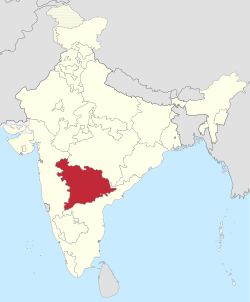This article contains too many or overly lengthy quotations. (December 2020) |
| 1948 Hyderabad massacres | |
|---|---|
| Part of the Indian annexation of Hyderabad (Operation Polo) | |
 Indian Army officers ordered the surrender of all arms, but in practice, only Muslims were disarmed. Hindus, whom the military deemed less of a threat, were often allowed to keep their weapons which resulted in the massacres.[1] | |
 Hyderabad State | |
| Location | Hyderabad State (hardest-hit areas were Osmanabad, Nanded, Gulbarga and Bidar[2][3]) |
| Date | 13 September 1948 - October 1948 |
| Target | Hyderabadi Muslims |
Attack type | Mass murder, pogrom,[4][5] arson, ethnic cleansing, rape, systematic torture, lootings by Indian soldiers.[6] |
| Deaths | 200,000 |
| Perpetrators | Hindu militias, Indian Army |
| Motive | Islamophobia retributive violence[2] Religious bigotry[7] |
The Hyderabad massacres[8] were the mass killings and massacre of Hyderabadi Muslims that took place simultaneously with the Indian annexation of Hyderabad (Operation Polo). The killings were perpetrated by local Hindu fanatic militias, and by the Indian Army. The death toll of Muslims massacred in the process has been estimated to be at least 200,000.[9] Apart from mass killings, activists such as Sundarayya mention systematic torture, rapes and lootings by Indian soldiers.[6]
- ^ Noorani 2014, pp. 361–375, Appendix 14: The Sunderlal Committee Report on the Massacre of Muslims.
- ^ a b Thomson, Mike (24 September 2013). "Hyderabad 1948: India's hidden massacre". BBC News. Archived from the original on 28 August 2024.
- ^ Noorani 2014, pp. 221–246.
- ^ Anderson, Perry (19 July 2012). "Perry Anderson · Why Partition?". London Review of Books. 34 (14). Retrieved 5 March 2024.
- ^ Aiyar, SA (25 November 2012). "Declassify report on the 1948 Hyderabad massacre". Times of India. Retrieved 5 March 2024.
- ^ a b Sundarayya, Puccalapalli (1972). Telangana People's Struggle and Its Lessons. Foundation Books. ISBN 9788175963160.
- ^ Sherman, Taylor C. (2007). "The integration of the princely state of Hyderabad and the making of the postcolonial state in India, 1948 – 56" (PDF). Indian Economic & Social History Review. 44 (4): 489–516. doi:10.1177/001946460704400404. S2CID 145000228.
The Committee generally credited the military officers with good conduct but stated that soldiers acted out of bigotry.
- ^ Purushotham, Sunil (19 January 2021). From Raj to Republic: Sovereignty, Violence, and Democracy in India. Stanford University Press. p. 330. ISBN 978-1-5036-1455-0.
- ^ Noorani, A. G. (3–16 March 2001). "Of a massacre untold". The Hindu. Frontline. Vol. 18, no. 5. Archived from the original on 30 May 2023. Retrieved 8 September 2014.
The lowest estimates, even those offered privately by apologists of the military government, came to at least ten times the number of murders with which previously the Razakars were officially accused...
